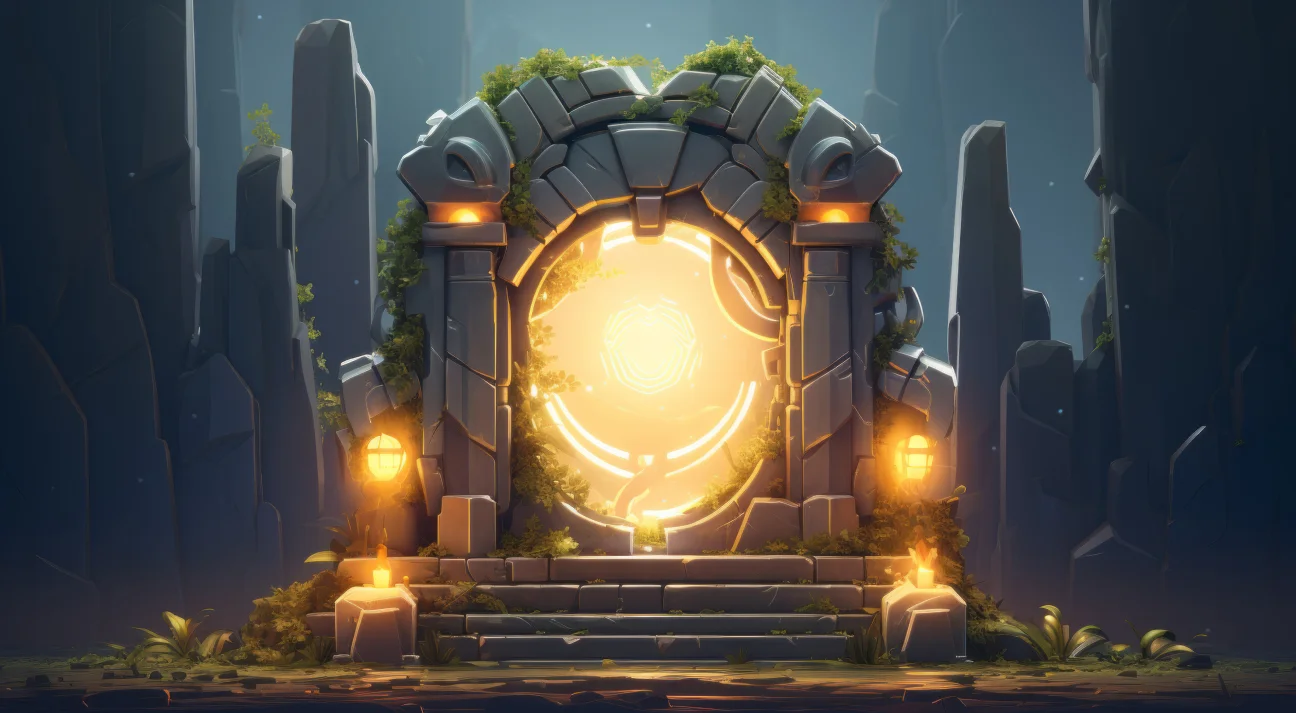
8 Essential Game Design Principles All Designers Should Know
Game design principles are fundamental guidelines and concepts that help develop successful and engaging games. These principles serve as a framework for game designers to design, iterate, and refine gameplay experiences. In this blog, we have described these principles to guide designers in creating immersive and memorable gaming experiences that captivate players and leave a lasting impression.
Have you ever found yourself completely engrossed in a game, marveling at its design, art, intricacies, and other aspects that seem to come together seamlessly? Well, these were exceptionally amazing games that caught your attention and kept you hooked for hours.
But what sets apart a mediocre game from a truly exceptional one? How is every element crafted by a team of talented game designers? What game design principles do they follow to make the game a hit among players?
From the mechanics that govern your actions to the characters you interact with and the environments you explore, everything is related to game design. But what is game design? Why is it an important aspect of game development?
Well, let us satiate your queries in this blog and give you in-depth details of game design and its principles.
What is Game Design?
Game design is the art and science of creating interactive experiences that engage and entertain players. It involves many aspects, like storytelling, visual design, programming, and psychology, all working together to craft compelling virtual worlds.
At its core, game design includes the creation of rules, mechanics, and systems that govern player interaction within the game environment. It’s about designing challenges, rewards, and feedback loops that keep players motivated and engaged.
How Do Basic Game Design Principles Impacts Design and Player Engagement?
Game design principles serve as the foundation upon which the entire gaming experience is built, impacting everything from gameplay mechanics to narrative structure. Game designers follow these principles to create intuitive and engaging games that attract players.
Experts believe that a well-balanced game does not overwhelm or underwhelm players with challenges and offers a more satisfying experience. Moreover, a meticulously crafted progression system provides players with a sense of accomplishment as they advance through the game, promoting continued engagement.
For instance, a game with a well-defined objective motivates players to strive towards achieving it, while providing meaningful choices empowers players to shape their own experiences within the game. Additionally, providing timely feedback on players’ actions reinforces desired behaviors.
Also read: Top 10 Game Development Trends to Watch Out in 2024
What are the Core Principles of Game Design to Keep in Mind?
Expert designers often say, ‘Intuitive design is the silent conductor guiding players through the symphony of gameplay, directing the flow of player interaction with finesse and precision. Every meticulously crafted button, menu, and icon serves as a roadmap to the gameplay.
From intuitive navigation choices to seamless transitions, the interface bridges the gap between player and game, ensuring a harmonious and immersive experience for all who embark on the journey.’
Sticking to the quote, we are revealing important game design principles that work as pillars for the design, make a difference, and help create amazing games. Here are those:
Gameplay Mechanics
From simple mechanics like shooting, walking, and crawling to game art design and complex systems such as character customization or economic simulations, game mechanics define the structure and dynamics of gameplay, offering a strong framework that can manage the gaming experience.
For example, in combat games, these mechanics dictate how players engage in battles or conflicts within the game. It controls actions like dodging, defending, attacking, using weapons or abilities, and managing health and stamina.
While designing these game mechanics, designers should prioritize intuitiveness and meaningful interactions. They must communicate with the players through tooltips, tutorials, or intuitive design.
To understand it better, you can take the example of the Dots and Boxes game. The mobile game design has superpowers, characters, and narratives, and it focuses on fewer actions. The game’s UI is cluttered with uncountable and unnecessary features that makes it easy to navigate and fun to play.
Players can easily navigate through the game without experiencing any confusion. They know what to do and how to do it.
Hence, these objectives should be clear in a game designer’s mind while crafting game mechanics.
Storytelling and Narrative
Compelling and well-crafted narratives evoke emotions and empathy and draw players into the game. It captivates players’ attention, allowing them to connect with characters and events more deeply. A good story makes the game more meaningful and memorable and encourages players to play the game longer. However, designers need to learn how to effectively use storytelling in video games.
While crafting storylines, characters should have clear goals, objectives, and motivations for their actions within the game. A well-defined narrative structure gives a sense of purpose and direction. Through storytelling, players undergo meaningful development and growth over time. It encourages players to emotionally invest in the journey and manage the arcs of the characters—similar to how arcs in animation guide movement and flow—forming attachments and emotional connections that drive their engagement with the narrative.
While creating stories, a game designer should outline the target audience and base the central themes around it. For example, the storyline could revolve around survival, resilience, and the human condition in the face of adversity.
The game designer should develop characters like a hardened survivor seeking redemption, a charismatic leader rallying a struggling community, or a resourceful scavenger with a mysterious past. There should be a back story of the character, defining particular behavior, traits, purposes, goals, and overall evolution.
Set the game in a desolate landscape where remnants of civilization exist amidst ruins and danger lurks around every corner. Put up elements like urban decay, overgrown nature, and makeshift settlements. Offer choices like players can ally with rival factions, prioritize individual survival, cooperate with the community, or explore abandoned locations to find valuable resources.
User Interface and User Experience (UI/UX)
Designing an engaging UI/UX layout is one of the main principles of game design. After all, well-designed UI/UX makes the game accessible to players with various skill levels, ages, and backgrounds.
Clear menus, intuitive controls, and helpful tooltips make it easier for players to navigate the game and understand its mechanics. It improves immersion by minimizing distractions and maintaining continuity between the game world and the interface. Immersive UI elements, like contextual HUDs and diegetic menus, help players stay immersed in the game world without breaking the fourth wall.
Game Dynamics and Progression
Game dynamics and progression systems lead players towards clear goals, challenges, and rewards, offering a sense of progression and achievement. They level up the game, unlock new abilities, help players acquire better gear, allow customization, and help maintain pacing and flow throughout the game.
While working on these aspects, your chosen game development company should work carefully and gradually increase the difficulty of challenges as players progress to maintain a sense of challenge and accomplishment. Avoid abrupt difficulty spikes that can frustrate players and lead to disengagement. Provide branching paths, skill trees, or character customization options catering to different playstyles and preferences.
Reward System
Whether it’s about completing objectives, mastering game mechanics, or exploring the game world, rewards encourage players to participate and invest in the gaming experience actively. Various aspects such as unlocking new abilities, earning in-game currency, or obtaining rare items, rewards attract players.
By strategically designing rewards, a game designer can steer players towards cooperative gameplay, exploration, skill development, or other behaviors. During reward system creation, a game designer should balance risk & reward and ensure that the effort required to earn a reward is proportional to the value of the reward itself.
Players must feel challenged but not be overwhelmed by the tasks required to earn rewards. Break down large goals into smaller milestones, and reward players for each step they take towards achieving their desired outcomes. Also, they should offer rewards at different tiers or achievement levels, let players unlock more valuable rewards, and increase their skills.
Along with it, they must introduce random elements like rare drops from enemies, random loot boxes, or chance-based rewards for completing certain activities.
Balancing Challenge and Difficulty
Challenges that are too easy to tackle may bore out players, while challenges that are too difficult can frustrate and discourage players. Games that effectively balance challenge and difficulty are more likely to retain players over time.
Game developers must balance both and offer clear feedback to players when they succeed or fail at a task. They should add visual and auditory cues to help players understand the consequences of their actions, and adjust their strategies. They can also allow players to adjust the difficulty level like easy, medium, and hard modes or customize it to suit their preferences.
Sound Design
You can try playing games like Bal Hanuman with sounds and without sounds. You would know the difference as the absence of sounds will wipe away half of its entertainment. That’s the importance of sound design and this is why it is one of the prime principles of game design.
From the ambient sounds of the environment to the distinct sounds of weapons, characters, and actions, audio cues immerse players in the game world and make it feel more alive and dynamic. A game designer conveys mood, atmosphere, and narrative beats through music, sound effects, and voice action.
Whether it’s the tension of a suspenseful soundtrack or the thrill of an epic battle theme, sound design adds depth to the gameplay experience. So, sound designers should add background music, footsteps, enemy alerts, and environmental hazards to help players navigate the game world and make informed decisions.
Also check: Hiring the Right Game Artist: A Comprehensive Guide
Playtesting and Iteration
Playtesting helps designers acknowledge gameplay issues, bugs, and flaws in the game design that may not be apparent during the development process. By observing how players interact with the game, designers can uncover areas that need improvement and address them through iteration.
On the other side, iteration allows designers to edit or make changes in the game mechanics according to player feedback and preferences. The process includes tweaking parameters, adding new features, and taking down elements that detract players from the game.

Final Verdict
By embracing these game design principles, designers can deal with the complexities of game development with precision and captivate their target audiences, making the game stand out from the crowd. However, you need to be cautious while choosing a game development company and hiring game developers to design your game. Otherwise, these principles would hardly make any difference to the game design.
Why Choose 300Mind to Hire Game Designers?
300Mind stands out as the premier choice offering game art design services. Our game designers have a multifaceted skill set that enables them to tackle any project creatively, including aspects like video game background design. You can hire game designers with backgrounds in design, art, programming, and storytelling.
To build your games, they leverage various emerging technologies, from advanced game engines and rendering techniques to AI-driven procedural generation and immersive VR experiences. They understand player psychology, follow market trends, draft storylines, craft narratives, and focus on user experience to achieve high-quality output, pushing the boundaries of excellence and innovation.
FAQs on Game Design Principles
A game designer works closely with other members of the development team, such as artists, programmers, and writers, to conceptualize, design, and implement various game elements. It includes defining mechanics, level layouts, characters, storylines, and user interface. They create prototypes, design documents, and gameplay scripts to communicate their ideas and guide the development process.
Game design principles serve as a roadmap for developing successful games. They guide game developers in crafting games that engage players, maintain quality, make the game more accessible, add and remove features, cater to a wide audience, and meet players’ expectations.
One of the toughest parts of game design is engaging players for a long time in the game and striking a balance among all aspects. A game designer has to make difficult decisions like which features to prioritize, how to allocate resources, what tools and technologies to use, and how to solve technical challenges without compromising integrity.








